A safety culture is not created overnight, but it remains one of the most cost-effective and powerful tools at the disposal of industrial organisations when tackling safety issues such as Drops.
In Why a strong safety culture is critical for effective Drops prevention, we defined what a safety culture is in principle. The next stage is establishing what a best practice safety culture looks like in reality, and how organisations can nurture one successfully.
There are four key steps to creating an organic and resilient safety culture throughout a business:
1. Empower frontline personnel
2. Raise awareness
3. Establish robust reporting
4. Train personnel at all levels
1. Empowerment
A safety culture can be supported and accelerated by decision-makers, but the most effective approach to creating a safety culture is building one from the bottom up. The role management play is empowerment – giving frontline personnel the resources they need to tackle issues while relaying to employees that the organisation genuinely cares about their safety.
Two examples of employee empowerment are safety committees and ‘time out for safety’:
Cross-business safety committees
Creating a safety committee that includes every level of the business not only gives personnel a voice. It’s a vital mechanism to ensure that invaluable ‘on the ground’ intelligence gained by personnel on the front line – who ultimately stand to lose most from Drops – can be efficiently distributed throughout all of a firms’ operations.
The ‘time out for safety’ campaign
Established over 15 years ago, ‘time out for safety’, or ‘stop the job’ is a way of enabling personnel to take responsibility for safety.
Operators should ensure that if a worker identifies a hazard, they can call for a temporary halt in operations until the issue is fixed. Since it prevents Drops incidents from occurring, sharing accountability for safety ultimately saves operators money.
2. Awareness
A holistic Drops prevention culture requires solid education on the risks at every level of organisations, and throughout the industry’s supply chain.
This means, at its core, sharing information. There are lessons to be learnt in this respect from Oil and Gas, where there is a strong culture of sharing incident data between operators, ensuring Drops prevention remains an evolving field. The next step is considering Drops incidents from the design of an asset or piece of equipment, through to the end of its life.
If they are not already doing so, facility managers should establish pre-tower/pre-job meetings before each shift. It is also common practice to have toolbox talks five minutes before each task proceeds. Building the latest guidance on Drops prevention into these meetings helps to prevent any potential incidents.
By sharing the latest safety bulletins and including recent incident reports in toolbox talks, HSE or facility managers can ensure that Drops prevention is always on the agenda at their facilities, helping to keep the risk front of mind for frontline personnel. More widely, an awareness of Drops at all levels of the supply chain, from facility design to transportation, reduces the risk of Drops by ensuring opportunities for incidents are removed.
3. Reporting
Building a Drops prevention culture also entails establishing robust internal reporting regimes. Otherwise, the true scale of this threat can remain unclear as many incidents and ‘near-misses’ fail to be recorded.
One issue is when smaller tools are knocked through gaps in railings. A Drops prevention Barrier system will eliminate this type of Drops incident – but without evidence of the challenge, it may be difficult for procurement departments to make an informed decision.
Across many facilities, there is a need to drive further uptake of these proven and cost-effective solutions by allowing personnel on site to communicate their needs. Improved reporting standards offer clarity during the decision-making process, ensuring that all personnel on site have access to and training with these solutions.
4. Training
To foster a comprehensive Drops safety culture at a facility, operators can support personnel in obtaining Drops awareness certification. Leading Drops prevention solution partners can advise on and recommend certified training providers, as well as deliver aspects of Drops training.
A culture of Drops prevention also means ensuring all personnel are equipped and trained with appropriate engineered solutions. An example of this is Drops incidents involving handheld tools, such as two-way radios, portable gas detectors or multi-meters, which may fall when personnel ascend project infrastructure and cause injury to personnel below. Ideally, this risk is mitigated using stainless-steel mesh pouches that can secure items and be attached to an engineer working at height.
These tools can also become Drops when working at height if they are loose and unattended, particularly fast-moving work environments. Drops trained facility managers will ensure that tools are tidied away safety after breaks, using posters to heighten awareness and building this guidance into toolbox talks.
Throughout all four of these steps, the key factor is transparency. An open approach to identifying, communicating, and tackling Drops risks is crucial in creating a durable safety culture. Most importantly, these measures are all either free or very cost-effective. It might take months to change mindsets throughout an organisation – but the results will be even more long-term.
For more information on building a Drops prevention safety culture, get in touch at info@dropsafe.com
